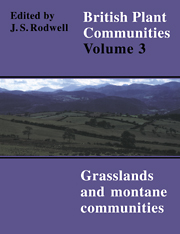Book contents
- Frontmatter
- Contents
- List of Figures
- Preface and Acknowledgements
- Preamble
- Mesotrophic Grasslands
- Community Descriptions
- Calcicolous Grasslands
- Community Descriptions
- Calcifugous Grasslands and Montane Communities
- Community Descriptions
- Index of Synonyms to Grasslands and Montane Communities
- Index of Species in Grasslands and Montane Communities
- Bibliography
CG5 - Bromus Erectus-Brachypodium Pinnatum Grassland
Published online by Cambridge University Press: 04 July 2020
- Frontmatter
- Contents
- List of Figures
- Preface and Acknowledgements
- Preamble
- Mesotrophic Grasslands
- Community Descriptions
- Calcicolous Grasslands
- Community Descriptions
- Calcifugous Grasslands and Montane Communities
- Community Descriptions
- Index of Synonyms to Grasslands and Montane Communities
- Index of Species in Grasslands and Montane Communities
- Bibliography
Summary
Synonymy
Inferior Oolite grassland Tansley 1939; Unaltered Oolitic Limestone grassland Hepburn 1942; Cirsio-Brometum typicum and astragaletosum Shimwell 1968a; Cotswold Limestone grassland Wells & Morris 1970; Pulsatilla vulgaris stands Wells & Barling 1971 p.p.; Jurassic Limestone grassland Ratcliffe 1977 p.p.
Constant species
Brachypodium pinnatum, Briza media, Bromus erectus, Carex flacca, Cirsium acaule, Festuca ovina, Helianthemum nummularium, Hieracium pilosella, Leontodon hispidus, Lotus corniculatus, Sanguisorba minor, Thymus praecox.
Rare species
Aceras anthropophorum, Astragalus danicus, Carex ericetorum, Galium pumilum, Herminium monorchis, Phyteuma tenerum, Polygala calcarea, Pulsatilla vulgaris, Thesium humifusum, Thymus pulegioides.
Physiognomy
This community comprises open or closed, sometimes rank and tussocky, swards in which complementary proportions of Bromus erectus and Brachypodiumpinnatum are dominant. In some cases, small tussocks of both species occur together in quite intimate mixtures; in others, more extensive patches of each make up more coarse-grained mosaics, as at Barnack in Northamptonshire, where Bromus tends to be more prominent over the ‘hills’ of spoil and Brachypodium in the ‘holes’ between (e.g. Hepburn 1942). Carexflacca and the finer grasses Festuca ovina and Briza media are constant and each can be locally abundant. Together, and frequently with some smaller amounts of Avenula pratensis and Koeleria macrantha, they often make up the bulk of the remainder of the sward, giving a generally grassy feel to the vegetation.
Some dicotyledons are, however, a constant feature of the community and may be locally abundant. The chamaephytes Hieracium pilosella, Thymus praecox and Helianthemum nummularium may all be patchily prominent, together with sprawls of Lotus corniculatus and, less commonly, Anthyllis vulneraria, Hippocrepis comosa and Asperula cynanchica. Sanguisorba minor, Cirsium acaule and Leontodon hispidus are constant and their rosettes occasionally abundant; other frequent hemicryptophytes are Scabiosa columbaria, Pimpinella axifraga and Campanula rotundifolia.
Although the distribution of the community is very much towards the limit of the ranges of many of the characteristic Continental rarities of British calcicolous grasslands, certain of these species do occur here. The most frequent is Pulsatilla vulgaris which now survives in this country mostly in these ranker swards and in similar vegetation dominated by B. erectus (Wells 1968, Wells & Barling 1971).
- Type
- Chapter
- Information
- British Plant Communities , pp. 184 - 187Publisher: Cambridge University PressPrint publication year: 1992

